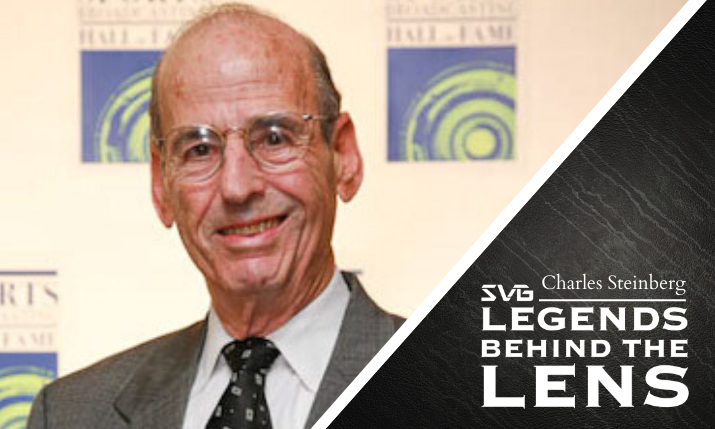Legends Behind the Lens: Charles Steinberg
When executives had an idea, Steinberg was the technical genius that made it reality
Story Highlights

The story of American sports television is engrained in the history of this nation, rising on the achievements of countless incredible men and women who never once appeared on our screens. During this pause in live sports, SVG is proud to present a celebration of this great industry. Legends Behind the Lens is a look at how we got here seen through the people who willed it to be. Each weekday, we will share with you the story of a person whose impact on the sports-television industry is indelible.
Legends Behind the Lens is presented in association with the Sports Broadcasting Hall of Fame and the SVG Sports Broadcasting Fund. In these trying times — with so many video-production professionals out of work — we hope that you will consider (if you are able) donating to the Sports Broadcasting Fund. Do so by visiting sportsbroadcastfund.org.
___________________________
by Ken Kerschbaumer
For more than 35 years, Charles A. Steinberg played an integral role behind the scenes at Ampex and at Sony Broadcast, turning the technical visions of industry leaders like Roone Arledge, Jules Barnathan, Don Ohlmeyer, and Ken Aagaard into sports-television realities.
Born June 7, 1934, in South Brooklyn, NY, Steinberg had a passion for engineering that led to a master’s of science degree from the Massachusetts Institute of Technology. In 1955, he headed to California to join Ampex, a relatively new company that would quickly dominate the broadcast-television–equipment market.
“I was drawn to Ampex because much of the innovation at that time was in television,” he explains, “and many of the first applications of a new technology were in sports. The people involved in sports production often were the first to suggest a new innovation.”
Steinberg began his career as an engineer at Ampex, where he was involved in designing the first system that allowed TV programs to be recorded in color on one reel of videotape.
During the next 35 years, he would be involved in a wide variety of videotape innovations. Two-inch tape, 1-in. helical tape, and Sony’s Digital Betacam and HDCAM formats were just some of the tape formats that Steinberg helped launch.
In terms of sports innovations, he says the 1968 Mexico City Olympics are a favorite memory. The coverage marked the Olympics debut for two technologies: handheld color cameras and the HS-100 color video magnetic-disk recorder that allowed slow-motion instant replay.
“Charlie Steinberg, in a lot of ways, is really the founder of the videotape replay that we all take for granted today.” — Ken Aagaard
The Olympics once again drove technology forward at the 1980 Lake Placid Games. Steinberg and Ampex turned another of Barnathan’s visions into reality: bringing digital video effects to the electronic still store. ABC Sports and Ampex together developed a system that allowed ABC Sports to apply digital video effects to a single frame of video.
“Charlie Steinberg, in a lot of ways, is really the founder of the videotape replay that we all take for granted today,” says Ken Aagaard, EVP, operations and production services, CBS Sports. “The technologies used at the Olympics by Barnathan, Marvin Bader, and later at NBC Sports were due in large part to Charlie.”
In 1988, after rising to president and CEO and board chairman, Steinberg left Ampex after it was sold in a leveraged buyout and joined Sony, where he was named president of Sony Electronics Broadcast and Professional Co.
In that role, Steinberg oversaw a decade-long product-development and marketing effort that would make Sony the leader in a new age of broadcasting: digital and high-definition TV.
In 1992, Sony launched the Digital Betacam format and, in 1996, built an all-digital production unit used by Fox Sports for the National League Championship Series and World Series.
Two years later. Sony Broadcast supplied HD equipment to CBS Sports that enabled the first-ever HD broadcast of a professional football game when the New York Giants and Buffalo Bills squared off on Nov. 8, 1998.
“To be successful, you need to surround yourself with people that are capable and strong, whether it is technology or marketing,” says Steinberg. “And you need to treat them the way you would like to be treated.”
Steinberg retired from Sony in 1999.
The video in this profile was originally produced in 2008. For more on the life and career of this industry legend, visit their profile at the Sports Broadcasting Hall of Fame.
